NOTE: For prior parts in the Hizballah Cavalcade series you can view an archive of it all here.
—
The Shia Militant Response to Ayatollah Nimr al-Nimr’s Death Sentence
By Phillip Smyth
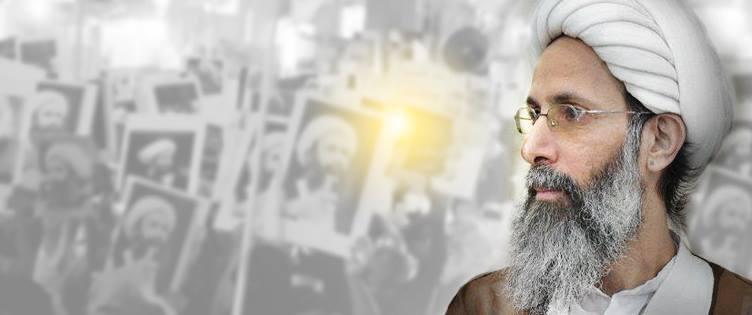
Ayatollah Sheikh Nimr Baqr al-Nimr, an outspoken radical Saudi Arabian Shia cleric, has been the center of controversy and brewing conflict between Shia protesters, militant Shia groups of Saudi Arabia and Bahrain, and their respective Sunni governments. According to a 2012 article by Toby Matthiesen, al-Nimr was, “long a peripheral figure in the local Shia power struggle but now seems to have become the most popular Saudi Shia cleric among local youth.”1 His cause and image is spreading across the Middle East as the latest example of Sunni oppression of Shia in the region and his recent death sentence has become a potent rallying cry for regional Shia militant organizations, particularly those with links to Iran.
Arrested in 2012, Nimr was accused by the Saudi government’s Special Criminal Court of making sectarian statements to cause strife, inviting foreign intervention (shorthand for Iranian influence), and disobeying the king. Following his 2012 arrest, thousands took to the streets and Saudi police shot and killed two protesters.2 In mid-October 2014, Nimr was sentenced to be “crucified”, a process where the sheikh will be beheaded and his body displayed.3
Protests in Saudi began in early 2011 and in part addressed anti-Shia discrimination suffered by the group in the Shia majority area in Saudi Arabia’s oil-rich Eastern Province; primarily zones around the Shia-majority towns and villages near the city of Qatif.4 Following the 2011 Saudi intervention in Bahrain, protests against the Saudi government increased in Bahrain and Saudi Arabia among Shia protesters.5 Following the 2011-2012 protests, links between Bahrain’s and Saudi Arabia’s protest movement spilled over into the more militant circles which actively promoted Nimr’s defiant stance and a hope to combine their fronts against common foes.
Of further interest are Nimr’s own ideological leanings and how they may relate to Shia militant responses. In Frederic Wehrey’s Sectarian Politics in the Gulf, the sheikh is described as a follower of the late Ayatollah Muhammad al-Shirazi.6 Shirazi was one of the founders of a radical Shia political school of thought referred to as the “Shiraziyya.” Shiraziyya clerics have been some of the most influential in the Arab Shia world. Initially al-Shirazi agreed with the Islamic revolutionary ideology of Ayatollah Khomeini, only to split from Khomeini over issues regarding how the new Islamic state (in Iran post 1979 revolution) should be led.7 In one BBC Arabic report, Nimr had been accused by Riyadh of attempting to spread Wilayat al-Faqih.8 Absolute Wilayat al-Faqih is the Khomeinist concept that serves as the basis for the Islamic Republic of Iran. Nevertheless, it was not clarified whether this was the type of Wilayat al-Faqih Nimr was accused of propagating.
Despite the history of strife between Shirazi’s school of thought and that of Ayatollahs Khomeini and Khamenei, al-Nimr appeared to increase public support for Tehran and send other more mixed messages. In 2008, he had also reportedly stated he supported Iran’s nuclear program by saying any attack against it should be met by a response from the Islamic world. That same year, he also said that Saudi Shia may need to call on foreign support (implying Iran) to help press their issues in Saudi Arabia.9 Later in 2009, Nimr reportedly called for secession, stating during a sermon, “Our dignity is more precious than the unity of this land.”10 His statement came as a response to discrimination against Shia in the kingdom and reflected possible repercussions if certain demands made by Shia protesters were not addressed.
Since 2013, in a piecemeal fashion, social media accounts associated with Iranian proxy groups in Iraq have promoted the images and other supportive statements for Ayatollah Nimr al-Nimr.11 While this does not necessitate that Nimr is a true ally or proxy of Tehran, his message and influence is likely seen by Iran as a cause to be promoted in that country’s wider struggle for the leadership of Shia Islam and as a counter to Saudi Arabia.
Nimr’s deep links and strong voice within the Saudi Shia community, particularly among youthful radicals and other more non-violent protestors, has led to Shia militant groups championing his cause from Bahrain and Iraq. Even in Yemen, Shia supporters of Ansar Allah, more commonly known as the Houthis, even launched demonstrations for the jailed cleric.12 Some Bahraini militant groups, which view the struggle of their coreligionists in a geographically close region of Saudi Arabia, as part and parcel to their conflict with the Khalifa monarchy and their Saudi government supporters. Additionally, powerful Iranian proxy groups based in Iraq—which have also maintained anti-Saudi and anti-Bahraini government narratives—have taken to issuing stern threats against Riyadh for his sentence.
The Violent Replies From Saudi Arabia’s and Bahrain’s Militants
Bahraini militant groups demonstrated the most concerted effort in terms of orchestrating violent retorts to Nimr’s jailing and sentence. While other threats and attacks were conducted since the start of 2014, this piece will focus on more recent threats and attacks beginning in the summer of 2014.
Bahrain’s Saraya al-Mukhtar (SaM), a group which once said the Saudi Shia of the Qatif and the Shia of Bahrain constituted one people with common foes, launched the most attacks over the longest period specifically addressing Ayatollah Nimr al-Nimr’s arrest, trial, and death sentence.
Starting in August, SaM attacked an electricity tower in Ar-Rifā near a Bahraini military base. The group filmed the attack and stated it had been a warning related to the imprisonment and trial of Ayatollah Nimr al-Nimr. Around the same time, SaM also began an online countdown for the Nimr verdict and increased their threats against Saudi Arabia. The group also ratcheted up it’s pro-Nimr messaging with the release of numerous images.
This messaging coincided with Saraya al-Mukhtar making its first direct threat against U.S. military personnel in Bahrain on August 11. Through an image posted to Facebook, SaM stated that, “The American cover on al-Saud and Al_Khalifa crimes,,Marines in bahrain will pay the price. [sic]” The message essentially claimed that the U.S. was the real backer for the Khalifa and Saud monarchies. As a result, they bore equal responsibility and could be targeted.

Figure 1: Saraya al-Mukhtar’s anti-American message posted on August 11, 2014.
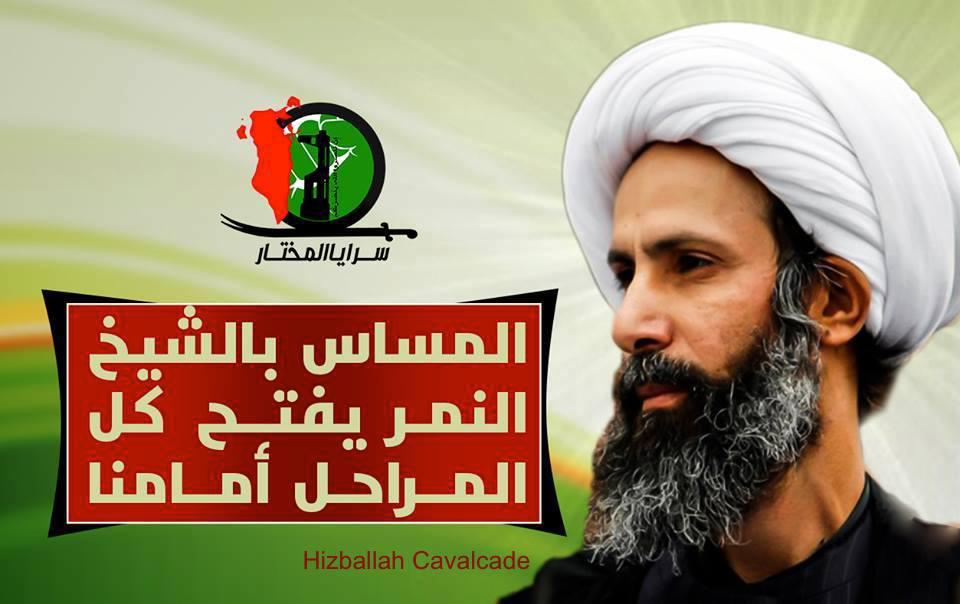
Figure 2: A Saraya al-Mukhtar photo for Ayatollah Nimr al-Nimr posted on August 8, 2014. The poster reads: “Sheikh Nimr[‘s trial and poor treatment] will make us put all options on the table.”

Figure 3: A Saraya al-Mukhtar photo posted on August 10, 2014. This poster reads: [in the red box] “A warning from Saraya al-Mukhtar to the mafia of the Sauds [in white text] Harming Sheikh Nimr will make us put all options [on the table]. Harming the Faqih Nimr means every single Saudi national will enter our country in a coffin.”
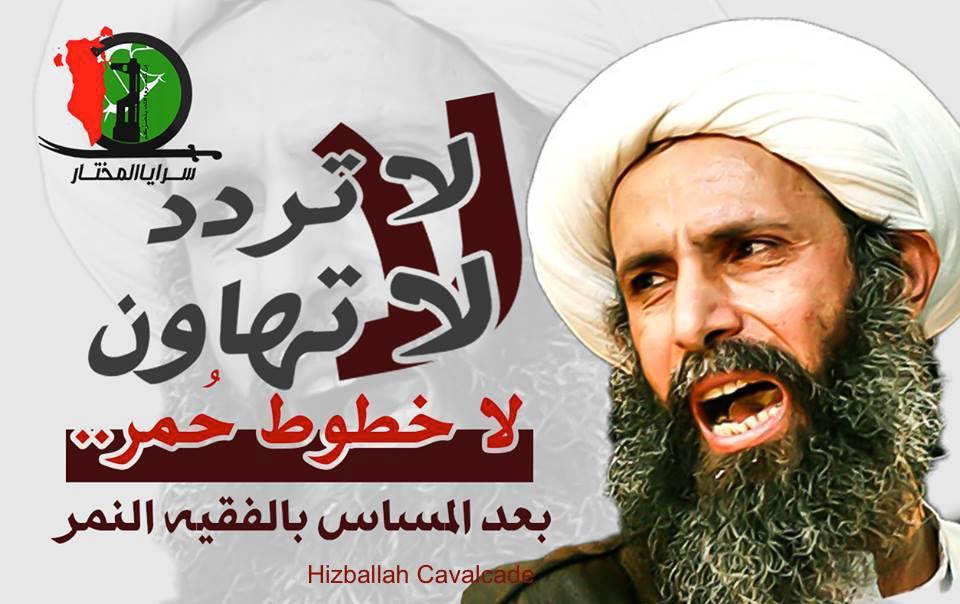
Figure 4: A Saraya al-Mukhtar photo for Ayatollah Nimr al-Nimr posted on August 11, 2014. The poster reads: “Do not hesitate, Do not underestimate, No red lines.. after [the] discrimination [against] the Faqih al-Nimr.”
On September 16, SaM announced it had planted 6 explosive devices in retaliation for al-Nimr’s incarceration. Albeit, these bombs did not target U.S. interests and there was little confirmation as to whether any devices were actually planted.
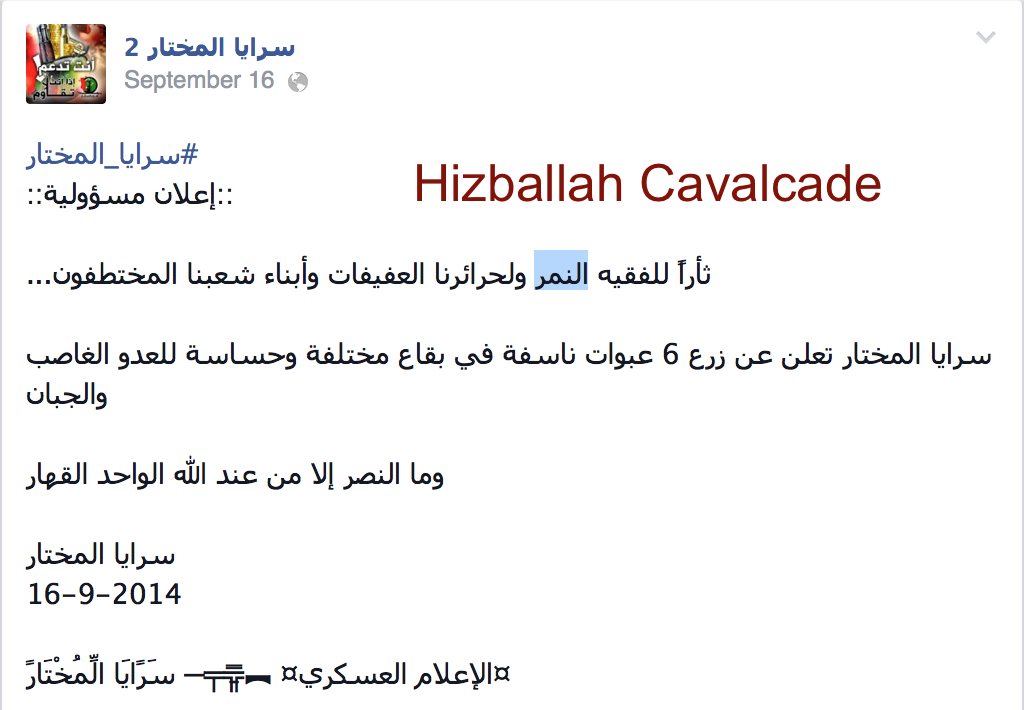
Figure 5: Saraya al-Mukhtar’s September 16 claim to have planted 6 bombs.
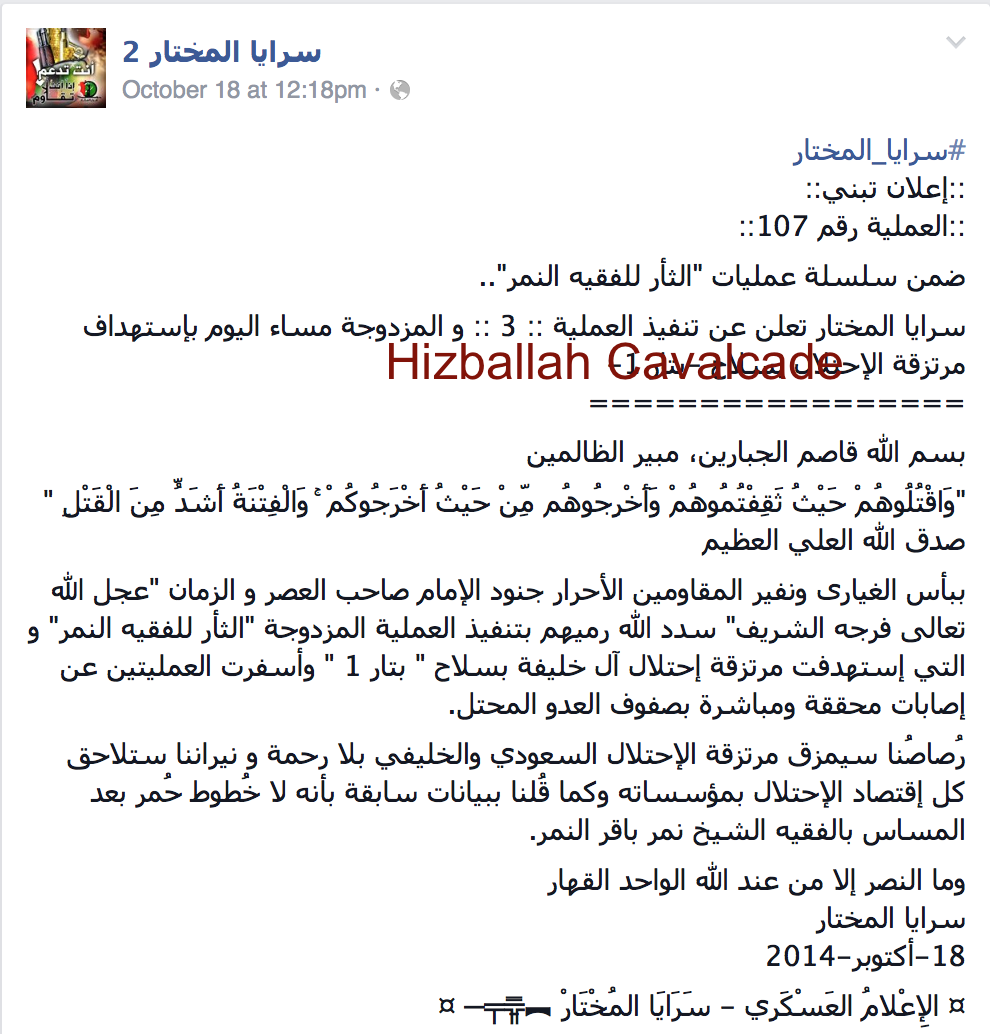
Figure 6: Saraya al-Mukhtar’s claim of 2 attacks on October 18, 2014.
Then on October 9, SaM claimed to conduct an attack in the town of Karana, Bahrain utilizing an improvised firearm. SaM’s claim of responsibility stated they attacked, “herds of mercenaries” (shorthand for Bahraini police and other security entities). On October 15, SaM claimed to have launched attacks in Sanabis and Aker, Bahrain targeting “mercenaries”. In another statement from that day, the group threatened, “The occupying mafia of al-Saud and al-Khalifa [would face]…consequences for the death sentence.” Later, on October 18, SaM claimed two attacks, referring to them as “Revenge of the Faqih [an expert in Islamic jurisprudence] Nimr.” SaM’s statement declared that it had injured “ranks of the enemy occupier.”
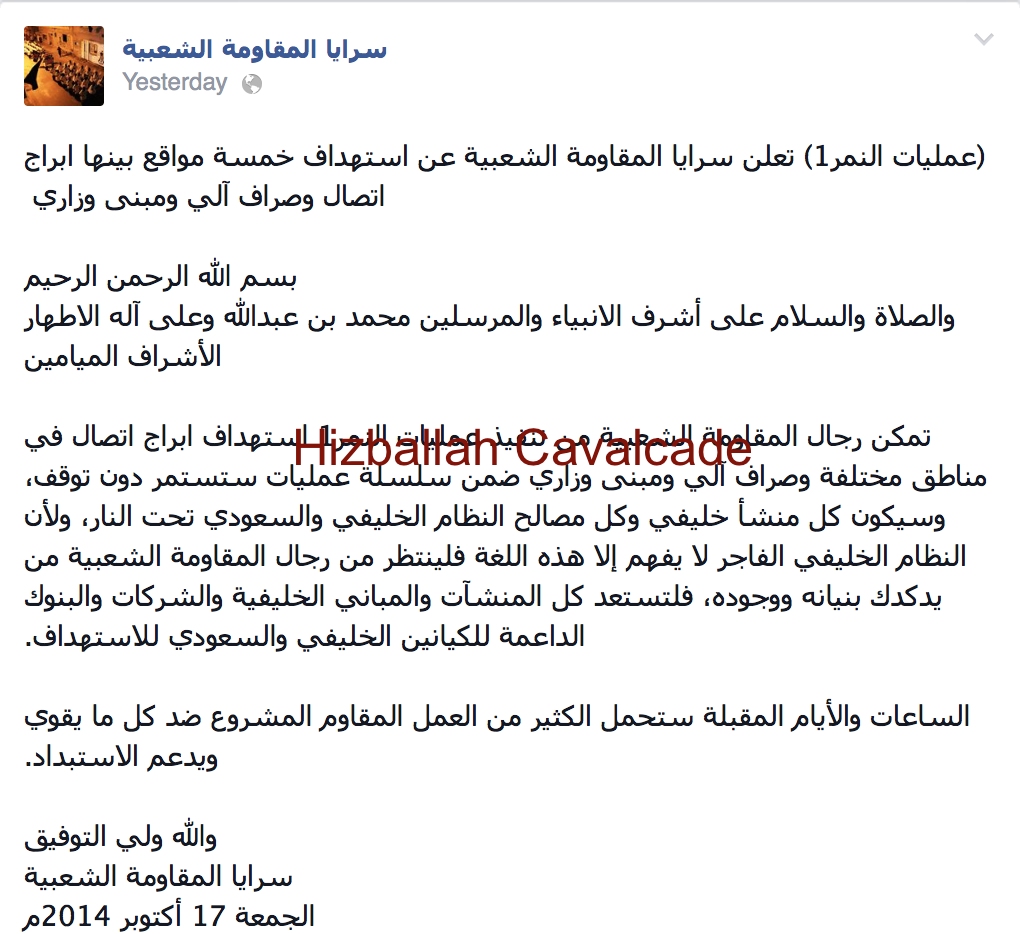
Figure 7: SMS’s claim of attack in honor of Sheikh Nimr.
Bahraini militant group, Saraya al-Muqawama al-Sha’biya (SMS), also claimed an attack against targets in honor of al-Nimr. On October 16 (albeit, the official statement says October 17), SMS referred to an attack as the, “Nimr 1 Operations .” During the “Nimr 1” attacks, SMS stated they had targeted communications towers and an ATM.
In Saudi Arabia, resistance to the verdict and Nimr’s imprisonment took on an approach of sporadic attacks against police checkpoints. While claims of responsibility for the attacks were rarely issued, they were often launched after demonstrators protesting Nimr’s imprisonment were subject to Saudi crackdowns (some violent). In fact, one late September attack occurred in Nimr’s hometown of al-Awamiyah.13
It would appear that attacks in Bahrain and possibly in Saudi Arabia’s Shia populated areas will increase. While often small scale and non-deadly in nature, there is the potential any upsurge in attacks could cause further unrest. Bahraini militants have already committed to “responding” to Nimr’s imprisonment and sentence.
Iraqi Shia Militias Issue Threats
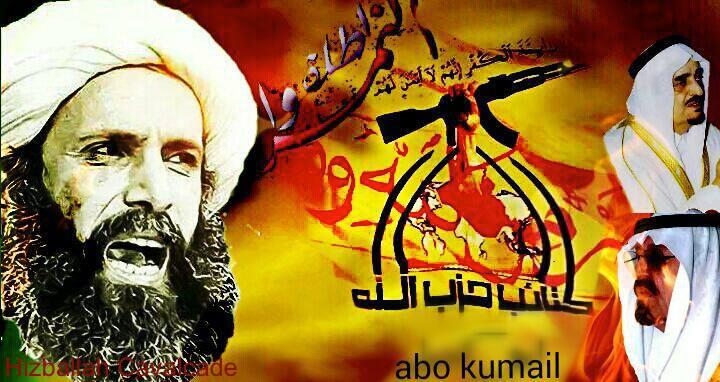
Figure 8: A photo circulated on some Iraqi Shia militia accounts. The picture combines the photos of Ayatollah al-Nimr (left), the logo for Kata’ib Hizballah (center), and Saudi rulers, including King Abdullah (bottom right).
Two of Iran’s many active Shia militia proxies in Iraq, Kata’ib Sayyid al-Shuhada (KSS) and Kata’ib Hizballah, released anti-Saudi threats in response to Nimr’s sentence on October 15, 2014 and October 17, 2014, respectively. Kata’ib Hizballah, a U.S. State Department foreign terrorist organization, has had a long history of issuing threats against Sunni Gulf states and even launched a series of attacks against occupying U.S. forces in Iraq to show solidarity with Bahraini protesters. KSS’s social media had also praised Saraya al-Mukhtar’s attacks in Bahrain.14 One of Iran’s other main Iraqi Shia proxies, Asa’ib Ahl al-Haq, utilized their political branch, the Sadiqoun Bloc (Kutla al-Sadiqoun) to express their own threats against Riyadh. MP Hasan Salem of the Sadiqoun Bloc said there would be “consequences” for Saudi Arabia after the verdict.15
Intriguingly, SaM’s claims that America bore responsibility for the actions of the Saudi and Bahraini governments were also echoed in Kata’ib Sayyid al-Shuhada’s released statement. KSS claimed that it was the U.S. which was behind terrorist attacks in Iraq and that along with Sheikh Nimr’s sentence, was the culmination of a wider conspiracy to pressure the Shia.
Another less well-known organization, Kata’ib Hizballah-Al-Mujahidoun, (not to be confused with Kata’ib Hizballah), offered other direct threats. Iraq’s Al-Masalah News claimed that Kata’ib Hizballah-Al-Mujahidoun was holding three Saudi hostages which the group threatened to execute if the Saudis executed al-Nimr.16 The Secretary General of Kata’ib Hizballah-Al-Mujahidoun, Sheikh Abbas al-Muhamidawi, also threatened his group would kill any Saudi the group detains or captures and also promised that “the Kata’ib Hizballah in Iraq, Lebanon, Syria and Yemen will have a response which they will not expect.”17 It is important to remember that al-Muhamidawi has offered other incendiary comments in the past. In December 2012, he announced that Kurds should be removed from southern Iraq.18 In July 2014, Muhamidawi also threatened Saudi Arabia with rocket attacks and that the Iraqi government should close the U.S. and Turkish embassies in Iraq.19
With threats coming from main and lesser known Shia jihadist elements, there is the potential for increased violence against Saudi and/or Bahraini interests in Iraq.
Translation of Kata’ib Sayyid al-Shuhada’s October 15, 2014 Statement20:
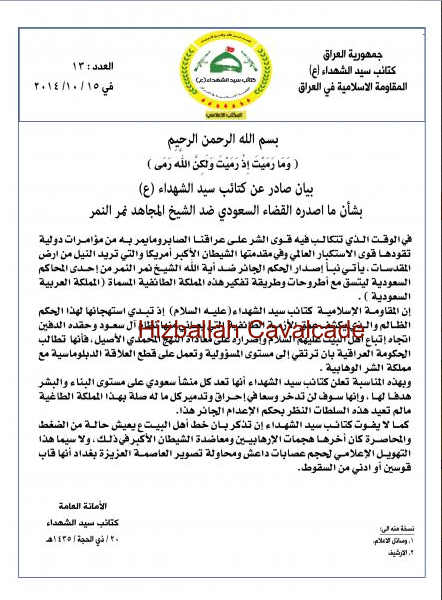
Figure 9: The original KSS statement about the group’s reaction to the execution ruling for Ayatollah al-Nimr.
At a time [when] the forces of evil are pouring [down] on our country, [and] in the time of international conspiracies which are being led by the world’s imperialist powers, primarily al-Shaytan al-Akbar (The Great Satan) America, which want to destroy the land of holy shrines, at this time comes the verdict against Sheikh Nimr al-Nimr in one of the Saudi courts. This verdict comes in line with the thinking of this sectarian kingdom called the Kingdom of Saudi Arabia.
The Resistance of Kata’ib Sayyid al-Shuhada condemns this unfair verdict, which proves how deep the sectarian crisis [is and] that the al-Saud regime is filled with hatred against Ahlul al-Bayt (People of the House of the Islamic Prophet Muhammad). Kata’ib Sayyid al-Shuhada calls on the Iraqi government to take responsibility and sever all ties with the Wahhabist Kingdom of Evil [Saudi Arabia].
Also on this occasion, if these [Saudi] authorities do not reconsider this appalling execution verdict, Kata’ib Sayyid al-Shuhada announces that they will be targeting every single Saudi establishment (infrastructure and human), and they will not spare any effort in burning and destroying everything that is related to this oppressive tyranny. Also Kata’ib Sayyid al-Shuhada will also mention that the people of Ahlul al-Bayt are in a state of being besieged and are under pressure. The last of this pressure were the attacks of terrorists and the role of the Shaytan al-Akbar in it. Additionally, the media fear mongering about the size of ISIS gangs and the [media] attempts to make it look as if the dear capital Baghdad is about to fall [added to this pressure].
Translation of Kata’ib Hizballah’s October 17, 2014 Statement21:
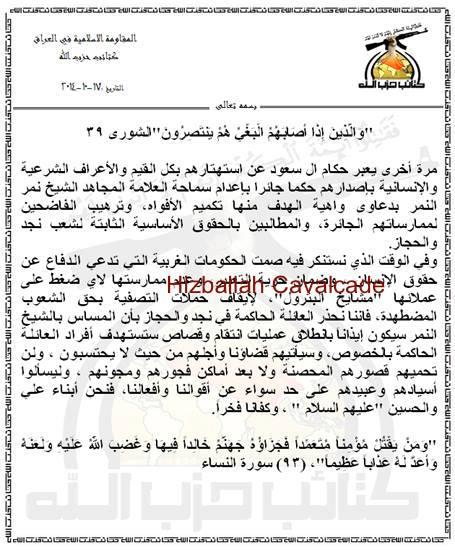
Figure 10: Kata’ib Hizballah’s original statement following Ayatollah al-Nimr’s sentence of execution.
[This is] another time the rulers of al-Saud are expressing their lack of care for all of the legitimate and humanitarian values by issuing an unfair verdict to execute the Mujahid Sheikh Nimr al-Nimr. [This verdict] aims to silence the mouths and terrorize the ones who exposed their unfair practices as well as the ones who demand basic rights for the people of Nejd and al-Hijaz.
At [this] time we denounce the silence of Western governments that pretend to be defending human rights and guarantee the freedom of expression, yet do not exercise pressure on any of its agents “the oil sheikhs” to have them stop the annihilation campaigns against persecuted people. We also warn the governing family in Nejd and Hijaz that harming Sheikh Nimr will mean the launch of revenge and punishment operations [by Kata’ib Hizballah] and these operations will target members of the ruling family. They will get their punishment when they least expect it and their palaces and fortified walls will not protect them. Let them ask their masters [the West] and slaves [regional proxies] about how truthful we are as we are the sons of Ali and Husayn and that is pride enough.
NOTES:
_____________
1 See: https://www.theguardian.com/commentisfree/2012/jan/23/saudi-arabia-shia-protesters.
2 See: https://in.reuters.com/article/2012/07/11/saudi-funeral-al-felfel-idINDEE86A06020120711.
3 See: https://www.bbc.com/news/world-middle-east-29627766 and https://www.voanews.com/content/death-sentence-for-saudi-cleric-sparks-protests/2487771.html.
4 See: https://www.npr.org/2013/03/23/175051345/in-saudi-arabia-shiite-muslims-challenge-ban-on-protests.
5 See: https://www.bloomberg.com/news/2011-03-16/saudi-arabia-demonstrators-hold-rallies-in-al-qatif-awwamiya.html.
6 Frederic M. Wehrey, Sectarian Politics in the Gulf From the Iraq War to the Arab Uprisings, (New York: Columbia University Press, 2013), P. 118.
7 Khomeini supported a concept of rule that created the position of an absolutist Supreme Leader whereas Shirazi supported a council of clerics to rule. See: Toby Jones, “Saudi Arabia,” in Assaf Moghadam (ed.), Militancy and Political Violence in Shiism: Trends and Patterns, (New York: Routledge, 2012), Pp. 139-144.
8See: https://www.bbc.co.uk/arabic/interactivity/2014/10/141016_comments_saudi_nimer.
9 Frederic M. Wehrey, Sectarian Politics in the Gulf From the Iraq War to the Arab Uprisings, (New York: Columbia University Press, 2013) P. 118.
10 See: https://www.washingtontimes.com/news/2009/apr/1/saudi-government-cracks-down-on-shiite-dissiden-1/.
11 Personal observations. This is particularly the case on accounts linked to Asa’ib Ahl al-Haq, Kata’ib Sayyid al-Shuhada, and Kata’ib Hizballah. Though, accounts promoting Lebanese Hizballah have rarely featured Nimr’s image.
12 See: https://uk.reuters.com/article/2014/10/18/uk-yemen-crisis-saudi-idUKKCN0I706H20141018.
13 See: https://www.middleeasteye.net/news/saudi-arabia-1295961083.
14 See: https://www.facebook.com/permalink.php?story_fbid=1486659381565338&id=1425347187696558.
15 See: https://alghadpress.com/ar/news/21989/%D8%A7%D9%84%D8%B5%D8%A7%D8%AF%D9%82%D9%88%D9%86-%D9%82%D8%B1%D8%A7%D8%B1-%D8%AD%D9%83%D9%85-%D8%A7%D9%84%D8%A7%D8%B9%D8%AF%D8%A7%D9%85-%D8%A8%D8%AD%D9%82-%D8%A7%D9%84%D8%B4%D9%8A%D8%AE.
16 See: https://almasalah.com/ar/NewsDetails.aspx?NewsID=39853.
17 See: https://www.alsumaria.tv/news/113521/%D8%AD%D8%B2%D8%A8-%D8%A7%D9%84%D9%84%D9%87-%D8%A7%D9%84%D9%85%D8%AC%D8%A7%D9%87%D8%AF%D9%88%D9%86-%D8%A8%D8%A7%D9%84%D8%B9%D8%B1%D8%A7%D9%82-%D8%AA%D9%87%D8%AF%D8%AF-%D8%A8%D8%A5%D8%B9%D8%AF%D8%A7%D9%85-%D8%A7/ar.
18 See: https://www.dw.de/%D8%A7%D9%84%D8%AF%D8%B9%D9%88%D8%A9-%D9%84%D9%84%D8%AA%D8%B7%D9%87%D9%8A%D8%B1-%D8%A7%D9%84%D8%B9%D8%B1%D9%82%D9%8A-%D8%AC%D8%B1%D9%8A%D9%85%D8%A9-%D8%B6%D8%AF-%D8%A7%D9%84%D8%A5%D9%86%D8%B3%D8%A7%D9%86%D9%8A%D8%A9/a-15875782.
19 See: https://www.alnahar-news.com/index.php?news=3530.
20 Note: Translation has been slightly cleaned-up so it can be more easily read by English speakers.
21 Note: Translation has been slightly cleaned-up so it can be more easily read by English speakers.
Hizballah Cavalcade: The Shia Militant Response to Ayatollah Nimr al-Nimr’s Death Sentence
Posted on

Attention Islamic State.
You might want to rethink your strategy and open a new front in Singapore where your power base is strong. Stretch the enemy thin.
Why singapore?
1. Economics play a vital role in a success or failure in an operation. Singapore passage has 1/2 the world’s oil and trade passing by. Imagine the damage to all the dar-al-harab, and the limiting effect it create in your enemy’s ability to wage war against you.
2. Singapore has a substantial trading businesses with your enemies. Israel alone has about a US$1 billion dollar investment here. A strike here would hurt badly.
3. Singapore’s multi-cultural/religious background means that singapore’s 5 tier defense plan, is very vulnerable. This is especially so because the government’s plan and expediting legalised corruption has lined it up as an enemy of the people and one that cannot be trusted. With a systemic corruption in place within the institutions of executive, legislative and executive. A fall is long overdue.
I will help in providing intelligence on key targets and especially oil and gas hubs- infil and exfil plans and contingencies. As well as other key targets that have been overlooked.